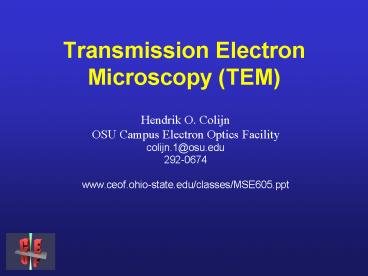Transmission Electron Microscopy (TEM) PowerPoint PPT Presentation
1 / 53
Title: Transmission Electron Microscopy (TEM)
1
Transmission Electron Microscopy (TEM)
- Hendrik O. Colijn
- OSU Campus Electron Optics Facility
- colijn.1_at_osu.edu
- 292-0674
- www.ceof.ohio-state.edu/classes/MSE605.ppt
2
TEM
- CM12 TEM/STEM
- CM200 LaB6 TEM
- Tecnai F20 (S)TEM
- Titan 80-300 (S)TEM
3
Why EM?
- Rayleigh Criterion
Let msinb 1, then d ? 300nm for light
4
Why EM?
- Rayleigh Criterion for electrons (small b)
l ? 0.003nm for electrons compared to 500nm for
light over 100,000x smaller! However, b is
smaller too.
5
EM vs. LM
- Electrons vs. photons different interaction
- Strong e- interactions require a thin sample.
- Possible radiation damage.
- Vacuum environment.
- Magnetic lenses -- charged particles wont go
through glass.
6
Sample constraints
- Vacuum compatible
- Electron-sample interaction different than for
light. Biological samples (and polymers) often
need stained. - Able to withstand radiation dose, needs to be
somewhat conductive.
7
TEM is a projection device
8
Similarity of LM and TEM
9
SEM
10
Illumination sources
- Thermionic
- Tungsten
- LaB6
- Field Emission
- Cold FEG
- Schottky FEG
11
Probe Currents vs. E0
12
TEM
13
TEM Schematic (CM12/EM400)
14
TEM Imaging
Remember -- you are looking at a 2D projection of
a 3D object.
15
Image vs. Diffraction
16
TEM Imaging
- In most cases, you are using amplitude contrast
rather than phase contrast. - Like light microscopy, you can do BF and DF
imaging. - You can also do diffraction from sub micron areas
to examine crystal structure.
17
STEM in a TEM
18
STEM detectors
19
STEM
TEM
STEM
20
HAADF STEM NiPt Catalyst
21
HAADF STEM NiPt catalyst
22
Ni3Al Z-contrast STEM
23
EDS unit
Oxford Instruments EDSHardwareExplained.pdf
Image courtesy of Oxford Instruments
24
EDS detector
Image courtesy of Oxford Instruments
25
TEM detector
26
EDS detector
27
Relative resolution
28
SEM EDS
29
TEM EDS - NiAl
Al Ka
Ni La
Ni Ka
Ni Kb
30
Ionization Cross-section, Q
- Probability of an electron ionizing an atom.
- Overvoltage U E0/Ec
- Bethe cross-section model
31
Cross-section vs. overvoltage
32
Fluorescence yield, w
- Probability of generating an X-Ray from an
ionized atom. - w a 1
- For k shell ionizations
- C 0.0013, S 0.06, Fe 0.3
33
Fluorescence Yield
34
UTW vs. Be Window
35
Cliff-Lorimer equation
Ca Cb are in weight percent (a tradition
started by Castaing)
36
Cliff-Lorimer equation
- C-L equation describes relative concentrations
and gives only n-1 equations for n elements - The nth equation is to require the sum of the
concentrations 1. If you neglect an element,
the calculated concentrations will vary from the
true concentrations though the relative amounts
are OK. - The C-L equation neglects absorption and
fluorescence. It is exactly valid only in the
thin film limit (i.e. at t 0).
37
k-factors
- kab-factors are relative sensitivity factors.
Always reported with respect to another (usually
common) element. - The original reference element was Si because
Cliff and Lorimer were geologists. Metallurgists
will often use Fe. - We can use theoretical k-factors, but
38
Theoretical k-factors
39
Electron Energy Loss
- GIF (Gatan Image Filter)
- In-column filter
- EELS spectrum
- Energy filtered imaging
40
EELS Post-Column Spectrometer
41
GIF spectrometer
42
In-Column Spectrometer
43
In-column energy filter
44
EELS Spectrum
45
Zero-loss image
Unfiltered
Filtered
46
EELS Spectrum
47
N background 1
48
N background 2
49
N background extrapolation
50
N gross peak intensity
51
N net EELS image
52
TEM techniques
- BF/DF
- Stain specificity
- Low dose
- Diffraction
- Selected Area
- Convergent Beam
- HREM
- Weak phase object
- Aberration correctors
- STEM
- Tomography
- Elemental Info
- EDS
- EELS
- Electron Spectroscopic Imaging
- Holography
53
References
- TEM (materials) Williams, D.B. and Carter,
C.B., Transmission Electron Microscopy A
Textbook for Materials Science, Kluwer/Plenum,
1996 - SEM Goldstein, J., Newbury, D., et al, Scanning
Electron Microscopy and X-Ray Microanalysis, 3rd
ed., Kluwer/Plenum, 2003

